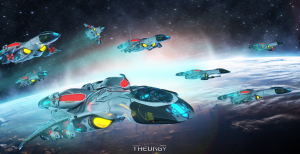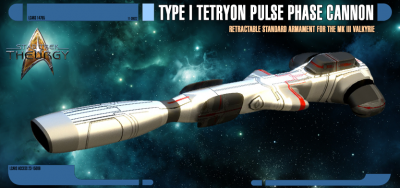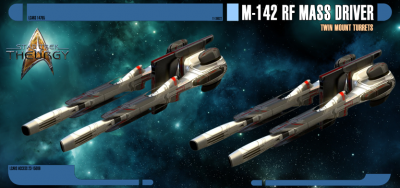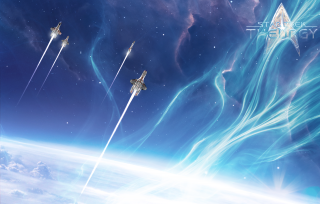AC-409 Mk III Valkyrie
From Star Trek: Theurgy Wiki
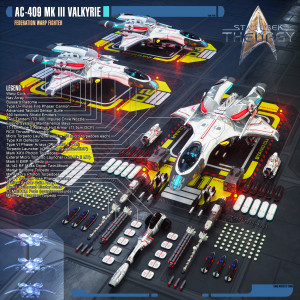
| |
| Name: | Mk III Valkyrie-class |
| Model: | AC-409 |
| Starship Type: | Federation Warp Fighter |
| Production Status: | Prototype Testing Stage |
| Role: |
|
| Constructed: | Antares Shipyards |
| Commissioned: | October 9th, 2378 Same as the USS Theurgy |
| Dimensions: |
|
| Mass (w. Standard Armament): | 25 700 kg |
| Technical Specifications | Advantages
|
| Standard Crew Complement: |
|
| Warp & Impulse Speeds: |
|
| Tactical Specs: |
|
| Defensive Specs: |
|
| Engine Specs: |
|
| Other Systems |
|
| Sensors |
|
| Other Standard-issue Equipment (stored in cockpit) |
|
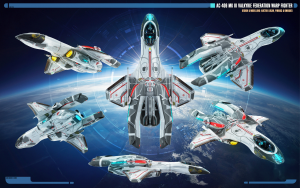 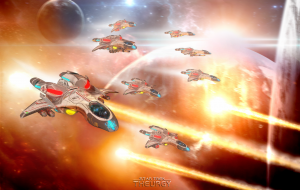
| |
These were the prototype warp fighters commissioned to the USS Theurgy at the end of the 24th century. There were originally 16 warp fighters on the Theurgy, and they were flown by the Lone-Wolves squadron.
As the war against the parasites that usurped political power in the Federation raged, many of the Lone-Wolves were KIA. With the destruction of their fighters, the availability of the Mk III was diminished. This was until the Theurgy obtained a few more at the Black Opal Weapons Facility at the end of March in 2381.
Fighter Demonstration 01
Fighter Demonstration 02
Production History
At the success of the Mk II and the fleet-wide deployment of the Valkyries in the fleet, Starfleet Command began looking into the Valkyrie with more interest. Initially, they considered Tactical CONN, another spear in Starfleet's arsenal. So when the project was given new funding, R&D went back to the drawing board to see what could be improved on an already formidable weapon.
The first step was to increase the command, control, and reconnaissance capabilities of the design. Originally, the Valkyrie (both Mk I and Mk II) employed an isolinear twin-core design computer system, with 372 isolinear banks and 106 command pre-processors and data analysis units. This design was quite successful for the use of standard comm traffic control and tactical targeting, but newer sensor package upgrades intended for the Valkyrie were hampered by a core that was already at its limit for processing power. So, with the eagerness of little boys with a new toy to take apart, R&D - under the direct involvement of Director Rennan Cooper - they began to work on the third iteration of the Valkyrie warp fighter.
By that time, Hyperjet Quantite Mk IV reactor cores were being successfully implemented in the experimental Knight-class Mk I Interceptor. These core types could be sized variably (depending on the design requirements) while still maintaining a very high energy output. A twin-core design was drafted for the new Mk III, and projected numbers suggested the Mk III would see a 25% increase to power output than the Mk I & II series. With this increase in power output, a larger computer core system was designed. Utilizing bio-neural processors and relays, the original frame space needed for the computer systems was reduced and spread out through the center-line of the craft. Computational capacity and storage was increased by another 30%, and a new tactical link-up library software system was implemented. The system provided a clearer and more accurate battlefield image for the pilot, and the integration was so effective that the RIOs were no longer needed - only one pilot was required in the cockpit.
With this new freedom of space within the spacecraft hull, R&D decided a more streamlined hull would benefit the pilot. Their new, sportier look reduced sensor cross-section and improved warp field stability for the twin quantite reactor cores. With the hull redesign came minor changes to weapons load-out: the arrangement of the standard Type-XII pulse phaser cannons and microtorpedo launchers in the Mk II changed only slightly to fit into the new spaceframe. The hard-point system was simplified, and the pulse phaser cell-magazine rack was switched from a vertical feed system to a horizontal feed system – this to combat original design flaws and jams during gravity-inducing combat maneuvers.
Lastly, one more weapon was added: a tetryon pulse phase cannon was installed on the underside of the cockpit within its own hull compartment. This cannon was installed for ground suppression roles, and to give the Valkyrie an added punch in the Space Superiority role. The drawback to the tetryon pulse phase cannon was its limited ammunition and craft maneuverability when utilizing the weapon. Though the weapon itself could effectively neutralize enemy engines and weapons systems, as well as do considerable kinetic energy damage, the weapon itself failed at a remarkable rate when engaged in combat maneuvers. A straight-line course was required for the weapon to work effectively, limiting it to the dangerous Head-to-Head combat maneuvers, and strafing of ground or orbital targets. With these weapon enhancements and increase in power, a slightly larger pair of shield generators were installed, increasing shield sustainable load to 390 isotons/second. The ablative armor was also thickened from 10.7 cm to 11.1 cm.
The top speed and warp capabilities of the Mk III remained virtually unchanged, but the increased power output from the new quantite cores benefited the improved avionics, sensor, weapons, and shield systems more than her speed. Despite this, the Valkyrie Mk III could easily go toe-to-toe with the fastest Interceptors currently in service. What she lacked in speed, she made up for in raw firepower.
As of 2381, the Mk III Valkyrie remained a prototype test model, but with the recent development in intergalactic politics and the potential Romulan threat, the project was pushed towards immediate deployment by Aerospace Command. So, since the new Theurgy-class starship - the USS Theurgy - was not only being fitted with an A.I. interphase, but with a fully operational (if small) fighter assault bay, the decision was made. The Theurgy was given a complement of sixteen Mk III fighters with their own Squadron Commanding Officer and a crew of thirty technicians hailing from Starfleet Operations or Engineering Corps.
The sixteen pilots were named the Lone-Wolves, and though decimated to only twelve pilots after their escape from Earth, the survivors kept fighting to preserve the truth of the corrupted Starfleet Command.
External Hard-point Options
The Mk III Valkyrie could hold up to four wing-mounted hard-points during missions, listed below.
ECM Pod/ECCM Emitter
Counter measures. ECM (Electric Counter Measure) was essentially a micro torpedo full of shrapnel and debris with the given craft's transponder signature and sensor reading. It confused the enemy ordinance and caused it to think the cloud of debris was the target. ECCM (Electric Chemical Counter Measure) created a wake similar to a warp, impulse, or thruster engine's wake, fooling such a guided missile into a false lock.
Additional Torpedo Launchers
Additional, wing-mounted torpedo launchers that can hold either 5 Mk XXVII photon torpedoes or 15 micro torpedoes. It was recommended to mount two of these in order to balance the fighter properly. This meant that the hard-point option of additional torpedo launchers either held 10 additional photon torpedoes in total when the Valkyrie was deployed into battle, or 30 additional mirco-torpedoes to complement those that the Valkyrie itself already had as standard internal armament.
Mk XXVII Photon Torpedo
Standard photon torpedo ordinance. The explosion was a matter-antimatter reaction producing large amounts of gamma waves as its primary means of destruction. While smaller in size, and harder to target mid-flight, each torpedo had the approximate yield of 70% compared to the Mk IV (the kind that Federation starships launched from their torpedo bays). This torpedo was deployed in the wing-mounted additional torpedo launchers (see above).
Mk Q-IV Quantum Torpedo
An improvement of the Mk XXVII photon torpedo with a higher yield, comparable to that of photon torpedo mounted on Federation Starships. This was a tactical quantum weapon, that utilized a plasma warhead and casings similar in shape to photon torpedoes. The explosion left an antimatter residue and although they were powerful weapons, even a direct hit from a quantum torpedo might not destroy neutronium alloyed targets.
Mk I Hellbore Torpedo
Photon torpedo type weapon that resulted in a nuclear fission reaction, named for its use of standard nuclear radioactive bomb materials (Uranium, Plutonium etc.) The nuclear bomb would detonate and compress the hydrogen into helium, creating a fusion reaction. Within the hydrogen core was a core of neutronium which the fusion reaction detonated. This detonation was the equivalent of a 3 photon torpedo that detonated only a few moments after it contacted its target rather than detonating near the target because of the penetrate-and-detonate-package in its casing. This weapon was highly ineffective against targets with fully powered shields. Against heavily armored targets without any shielding left, this might have been the only viable option that would punch through the heavy armor. The pilot could disable the penetrative package from the fighter to make one behave like a standard Tri-Nuclear Torpedo.
EMP Torpedo
Created the electromagnetic pulse similar to what was created from the high atmosphere detonation of a nuclear warhead. A well-shielded craft would withstand this easily but the weapon would detonate in a burst of broadband, high-intensity electromagnetic energy, capable of disrupting magnetic fields and producing current or voltage surges in conductive materials via magnetic induction.
Indirect damage to enemy hardware often proved substantial, and while it had a greater chance of disabling a small craft, the plasma surges could wound or kill soft targets if they were directly exposed.
Hellhound Cluster Bomb
Similar in nature to the photon torpedo, this was a photon torpedo filled with several micro torpedoes. Once the torpedo came in contact with an enemy or a surface, it detonated and fragmented into smaller torpedoes, which spread from the point of impact, also exploding on impact, resulting in a large pattern of torpedo detonations. Deployed correctly, this hard-point had the potential to cause severe damage when scattered upon enemy shields on impact. The torpedo snapped open by spring-force, and both the arming and the fuse was pilot-controlled by either manual or automatic settings. It could be armed prior to discharge or scattered by manual command.
Twin Mount Turrets
Twin Dual Cannon guns utilizing an ammunition replicator to create 30 mm Osmiridum shells. These shells were suspended in a small warp field bubble to render them nearly weightless before being electromagnetically propelled at a speed near mach 15 with a rate of up to 1000 rounds per minute, assuming all four cannons were being fired. Devastating against soft targets as well as being effective against armors of nearly all types, it was however, ineffective against shields, and its projectiles could be easily reflected via standard deflector arrays. The weapon could be placed in a fixed forward position or could be set to automatically track subsonic targets for fire, though it proved to be ineffective at automatically tracking fast moving small targets. It could hit large targets moving at high speeds but not with the same precision as expected with slow or fixed targets. Designed for aerial and suborbital assault on non-shielded Terrestrial targets, deep space strikes against bases, and aerial support of ground operations (see below for more information).
Type I Tetryon Pulse Phase Cannon
This was an advanced weapon system with two forms of fire. First was a form of a pulse phaser cannon that fired small concentrated tetryon pulses to mark a target. Once marked, the cannon then fired a concentrated phaser shot to cause damage similar to a Starship’s pulse phasers. Its second form of fire was a large concentrated tetryon pulse. This pulse was capable of weakening shields or disabling computerized systems, allowing for the ability to capture vessels without causing major structural damage.
Primary Firing Mode
Once fired, a thin, constant beam of tetryon particles was fired at the target. This stream painted the target for fire, making it easy for further targeting. After painting the target, the canon made minor adjustments to its aim and fired its primary weapon, a charged pulse phaser blast. This pulse phaser blast was stronger than the typical phase bursts from the wing-mounted pulse phasers and was more comparable to the pulse phaser cannons on a Defiant-class Starship.
A useful benefit to this weapon was how the telemetry data from the tetryon could be linked to other ships in the squadron or with other Starfleet vessels engaged in a battle. This effectively painted the target for all allied ships in an operation. With that ability, precision targeting by all forces became possible.
Using a squadron of fighters equipped with tetryon canons linked to a heavy weapons emplacement was shown to be an effective defense against cloaked warships. This was because all it took was for one fighter to spot the cloaked vessel by bouncing a tetryon pulse off of it. Once that was done, the signal could be sent to all other fighters and weapons emplacements to fire on the location of the cloaked ship.
Secondary Firing Mode
In this mode, the tetryon cannon fired a concentrated tetryon pulse. The ability of tetryon pulses to cause equipment malfunctions was proven time and again, so it made perfect sense to weaponize this trait. When the concentrated tetryon pulse impacted against a ship’s shields, the tetryon particles tended to weaken the shield bubble, creating a temporary weak point in the shield's systems. This could allow for another ship in formation to fire a more conventional weapon at the weak point, allowing for greater shield penetration than otherwise possible. Often, in order to use this “one-two punch” method of attack, the element leader would be the one using the Tetryon pulse cannon while his wingman followed up with a conventional attack.
While the tetryon Pulse was effective as a means of weakening shields, its greatest asset was revealed when used against a target rendered without shielding. When the particles impacted with a surface, they tended to penetrate through metal surfaces and pass through most armors, affecting whatever computerized systems were in the area near the impact of the pulse. The tetryon particles wreaked havoc on most computer systems, effectively disabling the systems in the affected area.
M-142 RF Mass Driver Twin Mount Turrets
The M-142 RF Mass Driver Twin Mount was a set of two dual-mass driver semi-automated turrets. These lethal devices were hard-point mounted on the undersides of the impulse drives, and in their default position they faced forward. Aimed similar to the micro-torpedo launchers and pulse phaser cannons on the Valkyrie, the targeting sensors' arc of fire could track and follow targets in an almost hemispherical firing arc. While the tracking systems were unable to effectively track and hit small agile targets like Shuttles Fighters and small auxiliary craft, it was effective at striking large targets, like starships, and could strike with pinpoint accuracy on stationary or slow moving targets such as Starbases, ground installations, or subsonic moving targets such as ground transports.
The nature of the weapon was less a conventional gun and in fact had far more in common with the tubes used to fire torpedoes on a starship, combined with the warp field bubble projectors used on the Valkyrie itself. By interfacing through the ship's power regulation systems the stardrive of the Valkyrie sent the necessary power to create a warp field bubble within the barrels of the weapon. This short lasting warp field formed around a 30 mm Osmiridium shell created via the weapon systems onboard replicator. Now virtually weightless, even near high G environments like outer atmospheres of Gas giants, the shell was pushed through a magnetic field coil, reaching speeds of Mach 15. Capable of a rate of fire of 250 Rounds per minute per barrel (a little over four rounds per second), with all barrels firing this allowed for a total of 1000 rounds per minute.
Its primary role in combat was not for space superiority (Fighter to fighter) warfare but as a means of aerial or orbital support for ground combatants. It was also quite suitable for pinpoint strikes on starbases or capital ships after their shields had been dealt with. With the correct sensor configurations, this weapon could also target via remote detection of tetryon reflection. This allowed a ground operative with a tetryon targeting based weapon to be used as a remote targeting system. These pulses could then be interpreted as a target by the turrets systems, allowing for ground units to effectively paint targets via tetryon pulse for a precision aerial strike. This added a 4th function to the Accipiter as its tetryon pulse systems could be used as a targeting system for the Twin mounts or any of the Valkyrie's other weapons systems.
Advantages
- Excellent at providing air support for ground operations.
- High rate of fire.
- Effective against conventional, energy reflecting, or ablative armors.
- Devastatingly effective against soft targets.
- Large targeting arc (360 degree rotational arc covering Forward, Aft, Port, and Starboard) with 15 to 66 degree ventral targeting arc.
- Could be set to fixed forward position.
- Cannons could be set to staggered bursts (4 barrels each fire in a sequence one at a time in a burst of fire) or in a 4 cannon Blast (all 4 fire at once in a single blast)
- When in forward position, it could be potentially devastating against other fighters if their shields had been taken down, providing the pilot could get a solid lock against their target. At close ranges or in atmosphere it could also be an effective close range dog-fighting weapons system similar to the use of guns on a real life jet fighter.
Disadvantages
- Maneuverability is slightly reduced
- These weapons are horribly ineffective against shielded targets.
- The Twin Mounts are rendered completely ineffective if fired in the arc of a ship's deflector array. Attacking the forward of a Starship with them was absolutely useless unless the deflector dish is inoperative.
- If damaged, there could be power loss from the engine systems.
- If severely damaged, there can be small scale localized warp core breach-like effects. Potentially sufficient to cause catastrophic failure of Impulse and stardrive systems up to and including a full scale warp core breech.
- The auto targeting systems were unable to effectively track agile small targets effectively.
- Twin Mounts have absolutely no ability to target above the fighter's "Horizon”, meaning there is no dorsal arc of fire.
- To be of use in a dog fighting scenario, the pilot has to be able to fly very well and get a manual target lock without any aiming corrections like with phasers or torpedoes.
Note
In the future that brought the Calamity-project to life, this system was improved on so heavily that the replicator, power supply, warp bubble generator, and rail gun firing system were able to be scaled down into a large rifle. The culmination of this research and progress was the RG-M1506 PT-10 Accipiter. The Accipiter used a rail gun operation while the Twin Mount's propulsion was a gauss gun based system.
Ejection Systems
Escape Pod
All Valkyries were equipped with ejection modules or "pods". These allowed for rapid emergency egress from the vehicle in case of danger. Linked to dedicated high speed processors, automatic sensors could detect certain types of danger and initiate an eject sequence automatically. This was especially useful if the pilot had been rendered unconscious through a blackout or other injury and the vehicle was in danger of crashing.
Modules had self-righting mechanisms in their base to ensure a correct orientation during landing. Landing was accomplished by a single use anti-grav module. Free falling until they were 3 meters from the ground, the ejection seat/pod activated the AG module, which burned out as it landed the unit (relatively) gently. The pod remained pressurized with approximately 20 minutes of air, allowing a pilot time to completely seal his suit and activate his personal survival equipment. Once ready, the pilot had the option of discarding the pod by activating a manual release.
ETS (Emergency Transport System)
By the late 24th century, emergency transport was further improved through Starfleet's development of a single-person, single-use, one-way emergency transport unit. The device was small enough to be hand-held and could transport to specified coordinates with a single touch. Because of its extreme limitations, this device was not widely deployed and was still considered a prototype in 2379. [see Star Trek: Nemesis]
The Valkyries have built-in Emergency Transport Systems (ETS) in the cockpit - not the small prototype version - designated to the pilot and worn gear alone, with a one-way pre-set location for the USS Theurgy. The Emergency transporter could be reprogrammed to send the pilot to a new location (chosen by the pilot) because of the possibility of long-range missions, but this system was best utilized in the event of defending the Theurgy - being within Transporter range.
